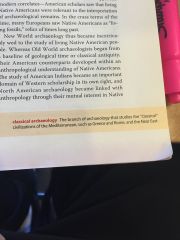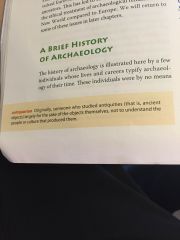![]()
![]()
![]()
Use LEFT and RIGHT arrow keys to navigate between flashcards;
Use UP and DOWN arrow keys to flip the card;
H to show hint;
A reads text to speech;
47 Cards in this Set
- Front
- Back
- 3rd side (hint)
|
Artifacts |
Any movable object that has been used, modified, or manufactured by humans. |
Humans
|
|
|
Classical archeaology |

Back (Definition) |
Classical civilization |
|
|
Antiquarian |

Back (Definition) |
Ancient |
|
|
Midden |
Refuse deposit resulting from human activities, generally consisting of sediment; food remains such as charred seeds, animal bone, and shell; and discarded artifacts |
Refuse |
|
|
Potsherd |
Fragment of pottery |
Pottery |
|
|
Stratigraphy |
A site's physical structure produced by the deposition of geological and/or cultural sediments into layers, or strata. |
Structure |
|
|
Culture history |
Practiced in the early to mid-twentieth century; it "explains" differences or changes over time in artifact frequencies by positing the diffusion of ideas between neighboring cultures or the migration of a people who had different mental templates for artifact styles |
Ideas of differences |
|
|
New archaeology |
An approach that arose in the 1960s, emphasizing the understanding of underlying cultural processes and the use of the scientific method; sometimes called processual archaeology. |
Scientific method |
|
|
Anthropology |
The study of all aspects of humankind - biological, cultural, and linguistic; extant and extinct - employing a holistic, comparative approach and the concept of culture. |
All aspects |
|
|
Biological Anthropology |
A subdiscipline of anthropology that views humans as biological organisms |
Biological organism |
|
|
Cultural anthropology |
Emphasizes nonbiological aspects: the learned social, linguistic, technological, and familial behaviors of humans. |
Not biological |
|
|
Linguistic anthropology |
Focuses on human language: it's diversity in grammar, syntax, and lexicon; its historical development |
Grammar |
|
|
Archaeology |
The study of the past through systematic recovery and analysis of material remains. |
Past; remains |
|
|
Participant observation |
The primary strategy of cultural anthropology, in which data are gathered by questioning and observing people while the observer lives in their society. |
Living within society |
|
|
Culture |
An integrated system of beliefs, traditions, and customs that govern or influence a persons behavior. |
Shared by a community |
|
|
Inductive reasoning |
Working from specific observations to more general hypotheses. |
Specific -- General |
|
|
Deductive reasoning |
Reasoning from theory to predict specific observational or experimental results |
Theory -- result |
|
|
Low-Level Theory |
The observation and interpretations that emerge from hands on archaeological field and lab work |
Hands on |
|
|
Middle-Level Thoery |
Hypothesis that links archeological observations with the human behavior. Archaeologically invisible. Natural processes of the past. |
Observational --- human behaviors |
|
|
High-level Theory |
Theory that seeks to answer the large "why" questions. An archaeologists ultimate objective. |
The large "why" |
|
|
Archeological site |
Any place where material evidence exists about the human past. |
Human past |
|
|
Projectile points |
Arrowheads, dart points, spear points |
Points from objects |
|
|
Systemic regional survey |
A set of strategies for arriving at accurate descriptions of the range of archaeological material across a landscape. |
Accurate --- Range of landscape |
|
|
Sample universe |
A sample that will characterize the statistical population of a region. Its size and shape are determined by the research question and practical considerations. |
Population |
|
|
Random sample |
A sample drawn from a statistical population such that every member of the population has an equal chance of being included in the sample. |
Equal chance |
|
|
Sample units |
Survey units of a standard size and shape. The choice of which to use depends somewhat on the research questions, but also on practical considerations. |
Square, triangle, circles |
|
|
Stratified random sample |
A survey universe divided into several sub-universes that are then sampled at different sample fractions. |
Sub universes |
|
|
Shovel testing |
Survey method used in regions where rapid soul buildup obscures buried archeological remains; it entails digging shallow, systematic pits across the survey unit. |
Digging shallow |
|
|
Remote sensing |
The use of some form of electromagnetic energy to detect and measure characteristics of an archeological target. |
Electromagnetic energy |
|
|
Ground-penetrating radar (GPR) |
A remote sensing technique in which radar pulses directed in the ground reflect back to the surface when they strike features or interfaces within the ground, showing depth and presence of buried features. |
Buried features are found |
|
|
Geographic- information system (GIS) |
A computer program for storing, retrieving, analyzing, and displaying cartographic data. |
Cartographic data |
|
|
In situ |
In position |
Meaning |
|
|
Datum point |
The zero point, a fixed reference used to keep control over the location of artifacts, features, etc. |
Zero |
|
|
Living floor |
A distinct buried surface on which people lived. |
Buried surface |
|
|
Geoarcheaology |
Applies the concepts and methods of the geosciences to archaeological research to assist in determining a site's age and its formation. |
Geoscience -- archaeology |
|
|
Law of superposition |
Older geological strata tend to be buried beneath younger strata. Formulated by Nicolaus Steno. |
Older under younger |
|
|
Systemic context |
Refers to artifacts as they are being used or manipulated by people |
Manipulated |
|
|
Archeological context |
Refers to natural processes that affect artifacts and features once they are deposited in the ground. |
Natural process |
|
|
Sample fraction |
The percentage of the sample universe that is surveyed. |
Percent |
|
|
Strata |
Rock layers or sometimes soil layers. It distinguishes itself from other layers by discrete changes in texture, compactness, color, rock, organic content. |
Rock |
|
|
Alluvial sediments |
Sediments transported by flowing water |
Water |
|
|
Colluvial sediments |
Sediments deposited primarily through the action of gravity on geological material |
Gravity |
|
|
Eolian sediments |
Sediments transported and accumulated by wind |
Wind |
|
|
Reverse stratigraphy |
When sediment is unearthed by human or natural actions and moved elsewhere. Older strata is now on top and newer strata is on the bottom. |
Older --- newer sediment |
|
|
Smithsonian number |
A cataloging system that most states use to keep track of their sites. Consists of the state's number, a letter abbreviation for the country, and the site's sequential number. |
Catalog |
|
|
Deflation |
Where fine sediment is blown away by the wind and larger items - including artifacts - are lowered onto a common surface |
Blown away --- common surface |
|
|
Landscape archeology |
The study of ancient human modification of the environment. |
ancient modification |

